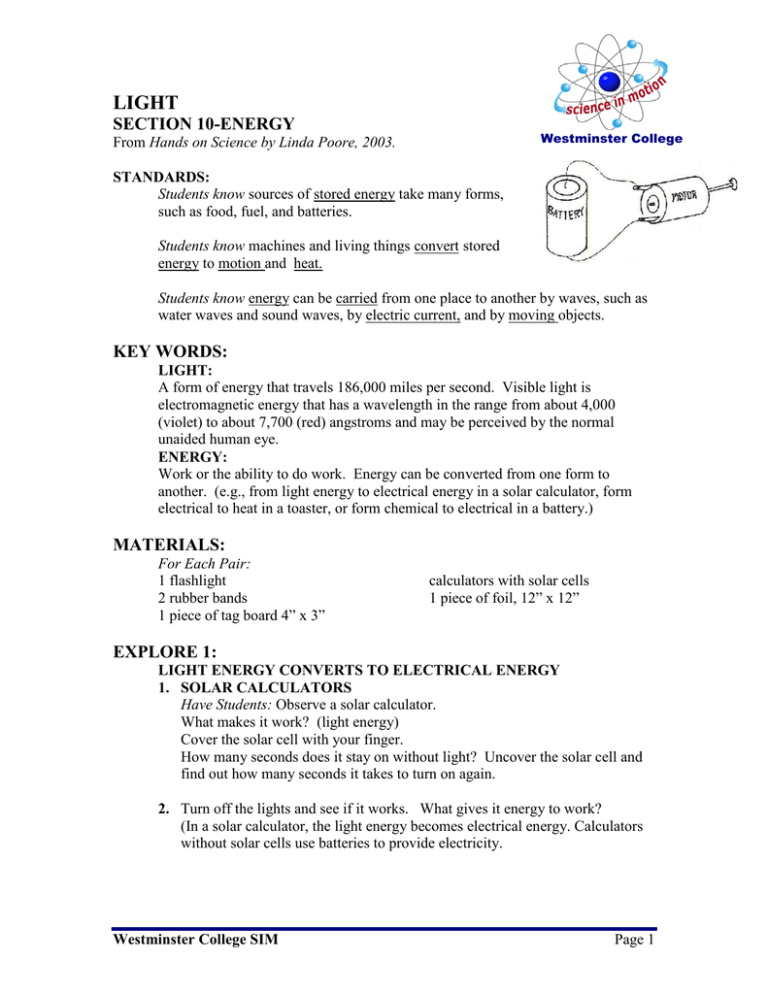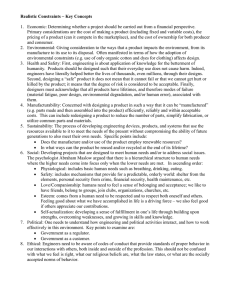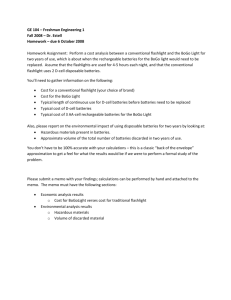LIGHT SECTION 10-ENERGY
advertisement

LIGHT SECTION 10-ENERGY Westminster College From Hands on Science by Linda Poore, 2003. STANDARDS: Students know sources of stored energy take many forms, such as food, fuel, and batteries. Students know machines and living things convert stored energy to motion and heat. Students know energy can be carried from one place to another by waves, such as water waves and sound waves, by electric current, and by moving objects. KEY WORDS: LIGHT: A form of energy that travels 186,000 miles per second. Visible light is electromagnetic energy that has a wavelength in the range from about 4,000 (violet) to about 7,700 (red) angstroms and may be perceived by the normal unaided human eye. ENERGY: Work or the ability to do work. Energy can be converted from one form to another. (e.g., from light energy to electrical energy in a solar calculator, form electrical to heat in a toaster, or form chemical to electrical in a battery.) MATERIALS: For Each Pair: 1 flashlight 2 rubber bands 1 piece of tag board 4” x 3” calculators with solar cells 1 piece of foil, 12” x 12” EXPLORE 1: LIGHT ENERGY CONVERTS TO ELECTRICAL ENERGY 1. SOLAR CALCULATORS Have Students: Observe a solar calculator. What makes it work? (light energy) Cover the solar cell with your finger. How many seconds does it stay on without light? Uncover the solar cell and find out how many seconds it takes to turn on again. 2. Turn off the lights and see if it works. What gives it energy to work? (In a solar calculator, the light energy becomes electrical energy. Calculators without solar cells use batteries to provide electricity. Westminster College SIM Page 1 ENERGY IN ADVANCE: Unscrew the top of the flashlights, leave the bulbs in this top section for the experiment. Tell students, “Do not drop the lamp part of the flashlight.” The lamp part can be attached under the rubber band to hold in on the side of the homemade flashlight. EXPLORE 2: CONVERTING ELECTRICAL ENERGY TO LIGHT ENERGY 1. Pass out the worksheet, How to make a flashlight. Let the students explore. Some students may need help unscrewing the flashlight. Do not remove the bulb, but have students use the whole top section in their flashlights. 2. Discuss the answers to the questions on the worksheet. Do not allow students to short the circuit (touch the foil to batteries without the bulb in the circuit) as it will quickly drain the batteries. Answers to worksheet: 1.Electrical, 2.Batteries, 4. Drawing: 2 batteries with flat on one touching bump of another. 10.Light MATERIALS: For Students: 10 batteries paper 10 cups to make a circle pattern 10 motors colored markers straight pins and T pins EXPLORE 3: WHAT COLOR DO YOU SEE? 1. Draw 8 circles (3” diameter) on your paper by tracing around the cup lip. Divide the circles in half, thirds, fourths, or sixths. 2. Color each circle differently. (blue and yellow, red, blue, and green, put one red spot near the edge of one circle, etc.) The circle with 6 divisions should be colored: red, orange, yellow, green, blue violet. 3. Stick a pin through the center and spin the color circle rapidly. What color do you see for each circle? (Your eyes mix the colors.) Westminster College SIM Page 2 ENERGY EXPLORE 4: MOTORS CONVERT ELECTRICAL ENERGY TO MOTION 1. Have students attach the motor to the battery. Observe. What kind of energy is in the battery? 2. Have students put the color wheels they made on the motors and observe. The colors appear to mix and make a new color. A dot makes a circular line. Blue and yellow makes green. Discuss. Show the most interesting designs to the class. 3. Have the students connect the motors to the batteries and leave the motors on the desks. What happens? Electrical energy is converted to sound energy and heat as the motor rubs on the desk. 4. Have students brainstorm to think of things they can attach to the motor axle to make louder sounds. MATERIALS: motors and batteries 2 x 2 pieces of paper (Post its™) objects to make sounds small binder clips 2 x 2 tag board EXPLORE 5: MAKING SOUND FROM ELECTRICITY 1. Let the students explore with the materials for 15 minutes. Give them 2” square pieces of paper or small binder clips to put on the motor’s shaft. clip the binder clips on firmly. (e.g., Make a fan or fold up the corners of the paper.) 2. Who can make the loudest sound with their motor sounding machine? Who makes the best sound? Who has the most creative design? 3. SOUND WAVES Sound energy moves through matter in waves. When something vibrates, it moves the matter around it. Student sound machines may tap a desk causing the desk to vibrate, carrying sound energy in waves through the desk to the air and form the air to your ear. Indians put their ear to the ground to find out if anyone was approaching because sound waves travel better through solids than air (gases). Sound does not travel in outer space because there is no matter to vibrate and carry the waves. 4. Students need to put the flashlights back together with the batteries. Have them turn on their flashlight to prove that it is working. Do not leave batteries in the flashlights for extended periods. Westminster College SIM Page 3 ENERGY HOW TO MAKE A FLASHLIGHT 1. What kind of energy lights the bulb? 2. What is inside the flashlight to give the bulb energy? 3. Unscrew the top of your flashlight. Remove the batteries from your flashlight. 4. Draw the 2 batteries showing how they touch each other in the flashlight. The end of the battery with the bump is the positive end. 5. Fold your foil 6 times to make a thick, long piece. This is your wire. Cut it in half to make 2 wires. 6. Roll the heavy paper around the 2 batteries. Be sure the batteries are touching the same way as your drawing above. Hold the paper on with a rubber band. 7. Put a second rubber band around the batteries, so one end of the rubber band goes over the positive end of the battery (the bump). 8. Attach a piece of foil at each end under the rubber band. 9. Look at the lamp part of the flashlight. What 2 places on this lamp do you think the 2 aluminum foil ‘wires’ should touch to light the bulb? Experiment. Draw a picture of your flashlight here: 10. In my flashlight, electrical energy is change to Westminster College SIM energy. Page 4



